Analysis: Reconstruction of a Nursing Theory (Watson's Human Caring)
VerifiedAdded on 2022/08/16
|6
|1536
|14
Report
AI Summary
This report provides a comprehensive reconstruction of Jean Watson's Theory of Human Caring, a prominent nursing theory. The report begins by outlining the metaparadigm of nursing, including patient, health, environment, and nursing practice, and then focuses on Watson's theory, which emphasizes the interpersonal relationship between patients and caregivers. The paper discusses the four stages of theory development: theorizing, syntax development, theory testing, and evaluation. The theorizing stage highlights the need for a multi-dimensional theory that addresses various aspects of care. Syntax development defines key terms like 'human caring' and its evolution into 'Caritas,' emphasizing love and compassion. Theory testing validates the theory's effectiveness through practical applications and patient-centered care. The evaluation step assesses the theory's impact on patient satisfaction and ethical considerations. The report concludes by highlighting the importance of the theory in contemporary nursing, emphasizing interpersonal care and person-centered approaches to meet the evolving needs of patients in the healthcare field.
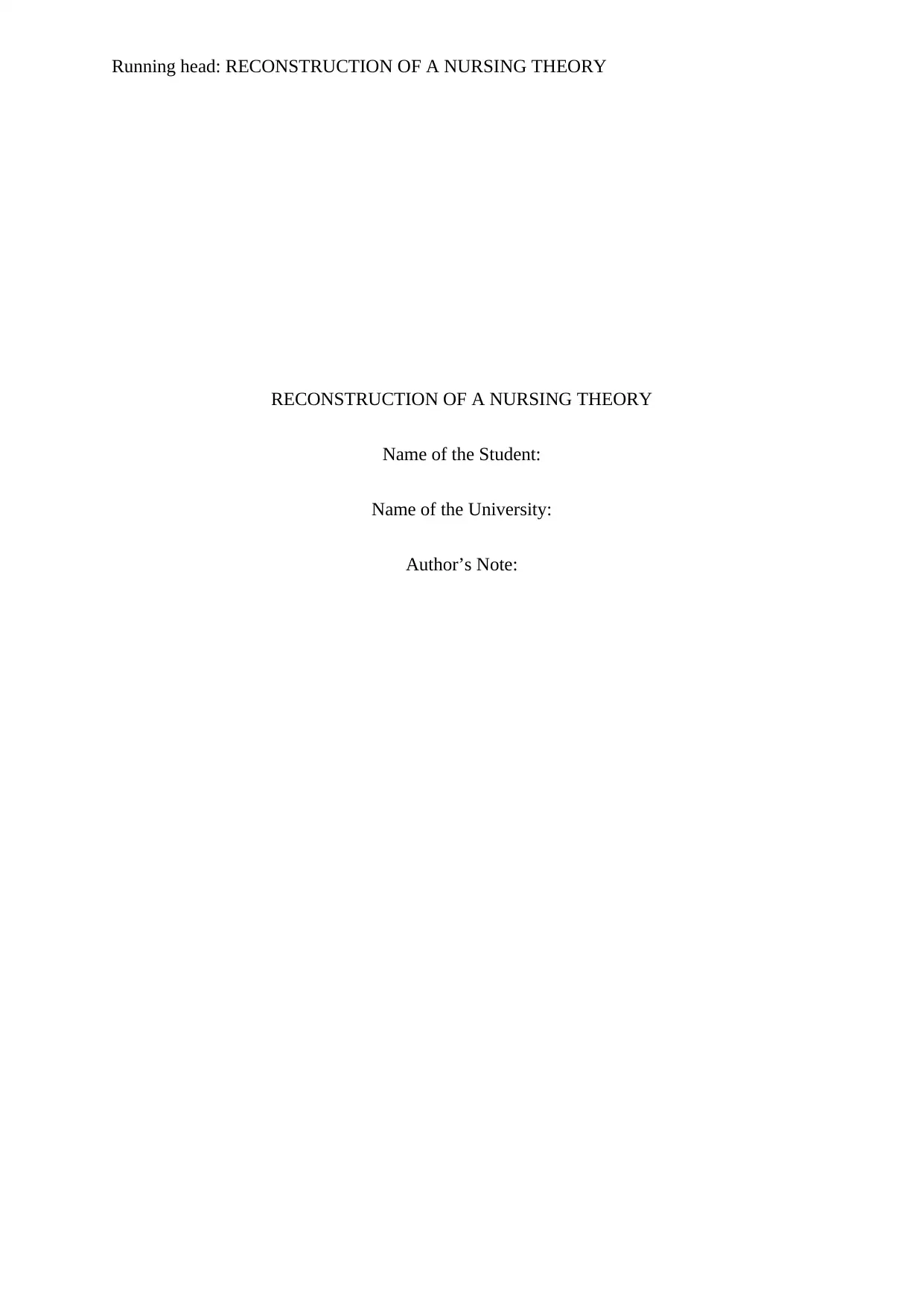
Running head: RECONSTRUCTION OF A NURSING THEORY
RECONSTRUCTION OF A NURSING THEORY
Name of the Student:
Name of the University:
Author’s Note:
RECONSTRUCTION OF A NURSING THEORY
Name of the Student:
Name of the University:
Author’s Note:
Paraphrase This Document
Need a fresh take? Get an instant paraphrase of this document with our AI Paraphraser
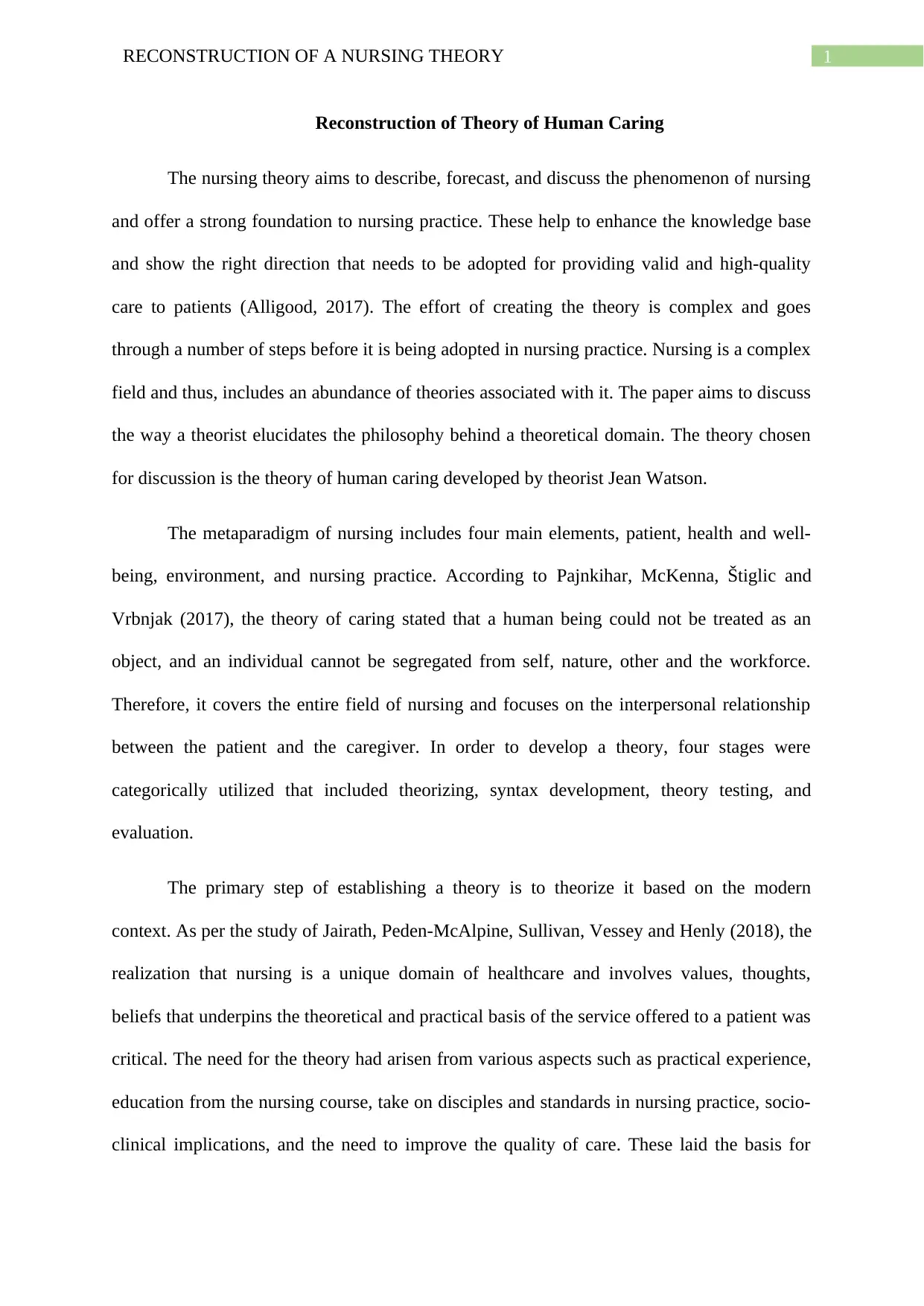
1RECONSTRUCTION OF A NURSING THEORY
Reconstruction of Theory of Human Caring
The nursing theory aims to describe, forecast, and discuss the phenomenon of nursing
and offer a strong foundation to nursing practice. These help to enhance the knowledge base
and show the right direction that needs to be adopted for providing valid and high-quality
care to patients (Alligood, 2017). The effort of creating the theory is complex and goes
through a number of steps before it is being adopted in nursing practice. Nursing is a complex
field and thus, includes an abundance of theories associated with it. The paper aims to discuss
the way a theorist elucidates the philosophy behind a theoretical domain. The theory chosen
for discussion is the theory of human caring developed by theorist Jean Watson.
The metaparadigm of nursing includes four main elements, patient, health and well-
being, environment, and nursing practice. According to Pajnkihar, McKenna, Štiglic and
Vrbnjak (2017), the theory of caring stated that a human being could not be treated as an
object, and an individual cannot be segregated from self, nature, other and the workforce.
Therefore, it covers the entire field of nursing and focuses on the interpersonal relationship
between the patient and the caregiver. In order to develop a theory, four stages were
categorically utilized that included theorizing, syntax development, theory testing, and
evaluation.
The primary step of establishing a theory is to theorize it based on the modern
context. As per the study of Jairath, Peden-McAlpine, Sullivan, Vessey and Henly (2018), the
realization that nursing is a unique domain of healthcare and involves values, thoughts,
beliefs that underpins the theoretical and practical basis of the service offered to a patient was
critical. The need for the theory had arisen from various aspects such as practical experience,
education from the nursing course, take on disciples and standards in nursing practice, socio-
clinical implications, and the need to improve the quality of care. These laid the basis for
Reconstruction of Theory of Human Caring
The nursing theory aims to describe, forecast, and discuss the phenomenon of nursing
and offer a strong foundation to nursing practice. These help to enhance the knowledge base
and show the right direction that needs to be adopted for providing valid and high-quality
care to patients (Alligood, 2017). The effort of creating the theory is complex and goes
through a number of steps before it is being adopted in nursing practice. Nursing is a complex
field and thus, includes an abundance of theories associated with it. The paper aims to discuss
the way a theorist elucidates the philosophy behind a theoretical domain. The theory chosen
for discussion is the theory of human caring developed by theorist Jean Watson.
The metaparadigm of nursing includes four main elements, patient, health and well-
being, environment, and nursing practice. According to Pajnkihar, McKenna, Štiglic and
Vrbnjak (2017), the theory of caring stated that a human being could not be treated as an
object, and an individual cannot be segregated from self, nature, other and the workforce.
Therefore, it covers the entire field of nursing and focuses on the interpersonal relationship
between the patient and the caregiver. In order to develop a theory, four stages were
categorically utilized that included theorizing, syntax development, theory testing, and
evaluation.
The primary step of establishing a theory is to theorize it based on the modern
context. As per the study of Jairath, Peden-McAlpine, Sullivan, Vessey and Henly (2018), the
realization that nursing is a unique domain of healthcare and involves values, thoughts,
beliefs that underpins the theoretical and practical basis of the service offered to a patient was
critical. The need for the theory had arisen from various aspects such as practical experience,
education from the nursing course, take on disciples and standards in nursing practice, socio-
clinical implications, and the need to improve the quality of care. These laid the basis for
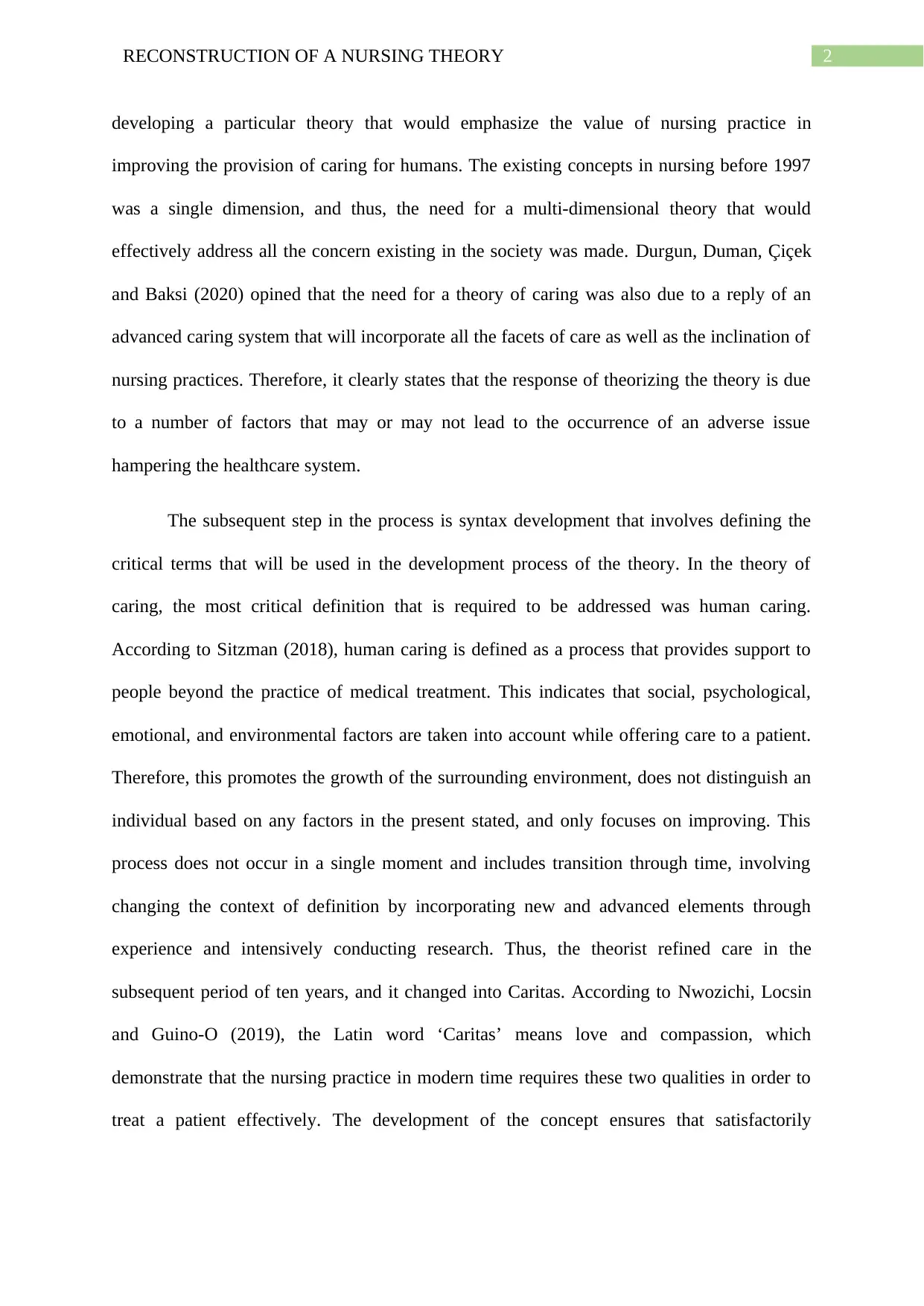
2RECONSTRUCTION OF A NURSING THEORY
developing a particular theory that would emphasize the value of nursing practice in
improving the provision of caring for humans. The existing concepts in nursing before 1997
was a single dimension, and thus, the need for a multi-dimensional theory that would
effectively address all the concern existing in the society was made. Durgun, Duman, Çiçek
and Baksi (2020) opined that the need for a theory of caring was also due to a reply of an
advanced caring system that will incorporate all the facets of care as well as the inclination of
nursing practices. Therefore, it clearly states that the response of theorizing the theory is due
to a number of factors that may or may not lead to the occurrence of an adverse issue
hampering the healthcare system.
The subsequent step in the process is syntax development that involves defining the
critical terms that will be used in the development process of the theory. In the theory of
caring, the most critical definition that is required to be addressed was human caring.
According to Sitzman (2018), human caring is defined as a process that provides support to
people beyond the practice of medical treatment. This indicates that social, psychological,
emotional, and environmental factors are taken into account while offering care to a patient.
Therefore, this promotes the growth of the surrounding environment, does not distinguish an
individual based on any factors in the present stated, and only focuses on improving. This
process does not occur in a single moment and includes transition through time, involving
changing the context of definition by incorporating new and advanced elements through
experience and intensively conducting research. Thus, the theorist refined care in the
subsequent period of ten years, and it changed into Caritas. According to Nwozichi, Locsin
and Guino-O (2019), the Latin word ‘Caritas’ means love and compassion, which
demonstrate that the nursing practice in modern time requires these two qualities in order to
treat a patient effectively. The development of the concept ensures that satisfactorily
developing a particular theory that would emphasize the value of nursing practice in
improving the provision of caring for humans. The existing concepts in nursing before 1997
was a single dimension, and thus, the need for a multi-dimensional theory that would
effectively address all the concern existing in the society was made. Durgun, Duman, Çiçek
and Baksi (2020) opined that the need for a theory of caring was also due to a reply of an
advanced caring system that will incorporate all the facets of care as well as the inclination of
nursing practices. Therefore, it clearly states that the response of theorizing the theory is due
to a number of factors that may or may not lead to the occurrence of an adverse issue
hampering the healthcare system.
The subsequent step in the process is syntax development that involves defining the
critical terms that will be used in the development process of the theory. In the theory of
caring, the most critical definition that is required to be addressed was human caring.
According to Sitzman (2018), human caring is defined as a process that provides support to
people beyond the practice of medical treatment. This indicates that social, psychological,
emotional, and environmental factors are taken into account while offering care to a patient.
Therefore, this promotes the growth of the surrounding environment, does not distinguish an
individual based on any factors in the present stated, and only focuses on improving. This
process does not occur in a single moment and includes transition through time, involving
changing the context of definition by incorporating new and advanced elements through
experience and intensively conducting research. Thus, the theorist refined care in the
subsequent period of ten years, and it changed into Caritas. According to Nwozichi, Locsin
and Guino-O (2019), the Latin word ‘Caritas’ means love and compassion, which
demonstrate that the nursing practice in modern time requires these two qualities in order to
treat a patient effectively. The development of the concept ensures that satisfactorily
⊘ This is a preview!⊘
Do you want full access?
Subscribe today to unlock all pages.

Trusted by 1+ million students worldwide
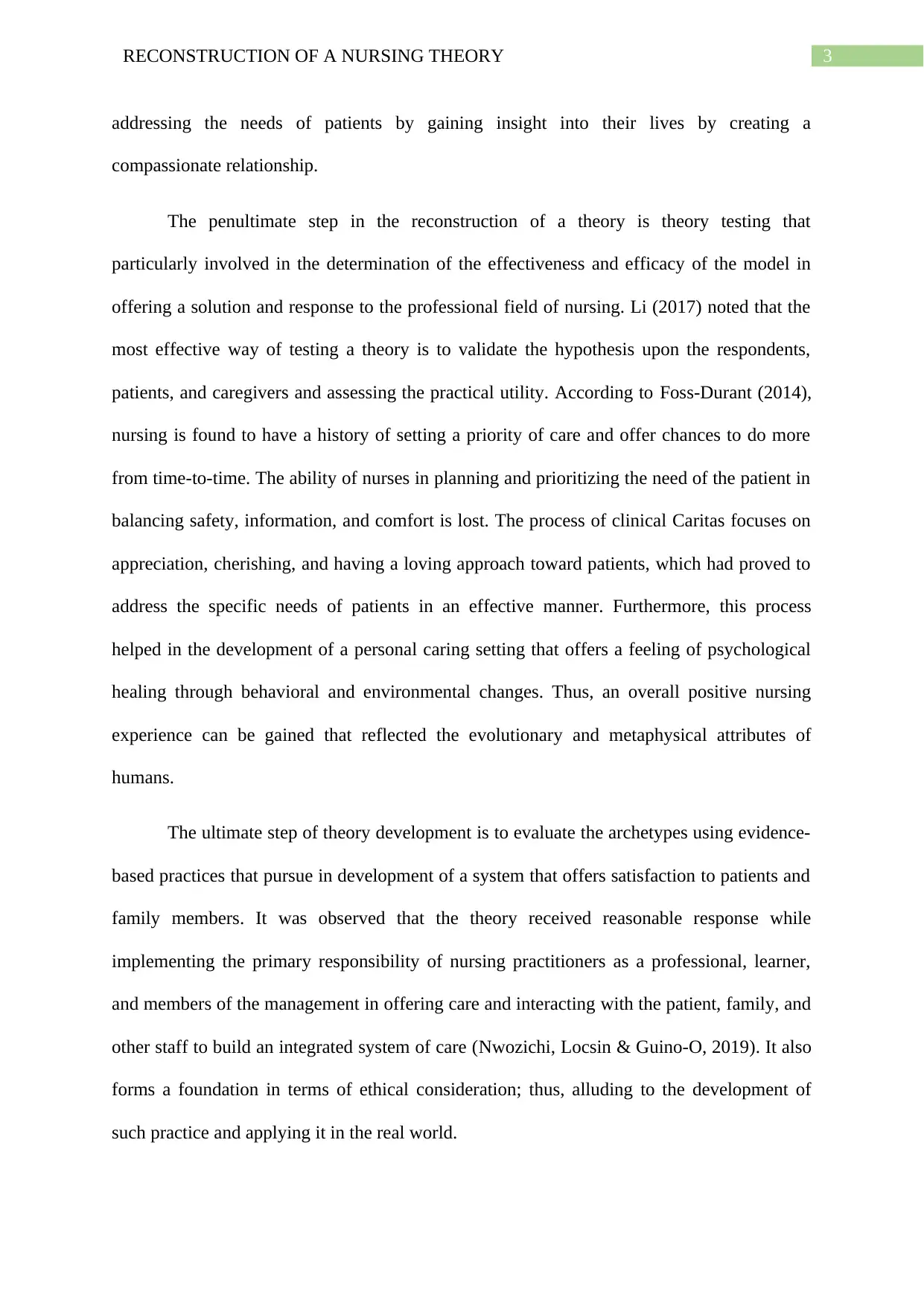
3RECONSTRUCTION OF A NURSING THEORY
addressing the needs of patients by gaining insight into their lives by creating a
compassionate relationship.
The penultimate step in the reconstruction of a theory is theory testing that
particularly involved in the determination of the effectiveness and efficacy of the model in
offering a solution and response to the professional field of nursing. Li (2017) noted that the
most effective way of testing a theory is to validate the hypothesis upon the respondents,
patients, and caregivers and assessing the practical utility. According to Foss-Durant (2014),
nursing is found to have a history of setting a priority of care and offer chances to do more
from time-to-time. The ability of nurses in planning and prioritizing the need of the patient in
balancing safety, information, and comfort is lost. The process of clinical Caritas focuses on
appreciation, cherishing, and having a loving approach toward patients, which had proved to
address the specific needs of patients in an effective manner. Furthermore, this process
helped in the development of a personal caring setting that offers a feeling of psychological
healing through behavioral and environmental changes. Thus, an overall positive nursing
experience can be gained that reflected the evolutionary and metaphysical attributes of
humans.
The ultimate step of theory development is to evaluate the archetypes using evidence-
based practices that pursue in development of a system that offers satisfaction to patients and
family members. It was observed that the theory received reasonable response while
implementing the primary responsibility of nursing practitioners as a professional, learner,
and members of the management in offering care and interacting with the patient, family, and
other staff to build an integrated system of care (Nwozichi, Locsin & Guino-O, 2019). It also
forms a foundation in terms of ethical consideration; thus, alluding to the development of
such practice and applying it in the real world.
addressing the needs of patients by gaining insight into their lives by creating a
compassionate relationship.
The penultimate step in the reconstruction of a theory is theory testing that
particularly involved in the determination of the effectiveness and efficacy of the model in
offering a solution and response to the professional field of nursing. Li (2017) noted that the
most effective way of testing a theory is to validate the hypothesis upon the respondents,
patients, and caregivers and assessing the practical utility. According to Foss-Durant (2014),
nursing is found to have a history of setting a priority of care and offer chances to do more
from time-to-time. The ability of nurses in planning and prioritizing the need of the patient in
balancing safety, information, and comfort is lost. The process of clinical Caritas focuses on
appreciation, cherishing, and having a loving approach toward patients, which had proved to
address the specific needs of patients in an effective manner. Furthermore, this process
helped in the development of a personal caring setting that offers a feeling of psychological
healing through behavioral and environmental changes. Thus, an overall positive nursing
experience can be gained that reflected the evolutionary and metaphysical attributes of
humans.
The ultimate step of theory development is to evaluate the archetypes using evidence-
based practices that pursue in development of a system that offers satisfaction to patients and
family members. It was observed that the theory received reasonable response while
implementing the primary responsibility of nursing practitioners as a professional, learner,
and members of the management in offering care and interacting with the patient, family, and
other staff to build an integrated system of care (Nwozichi, Locsin & Guino-O, 2019). It also
forms a foundation in terms of ethical consideration; thus, alluding to the development of
such practice and applying it in the real world.
Paraphrase This Document
Need a fresh take? Get an instant paraphrase of this document with our AI Paraphraser
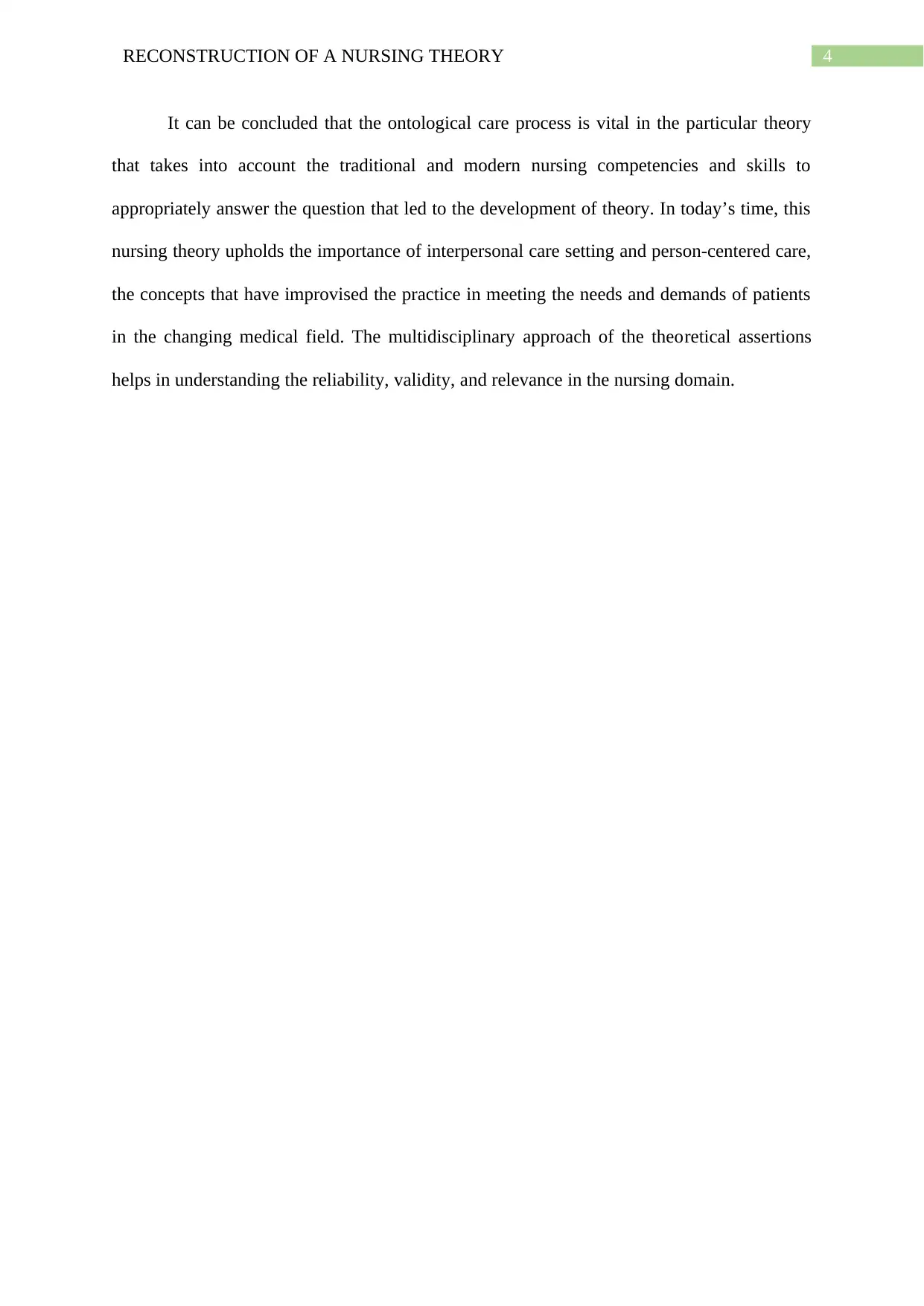
4RECONSTRUCTION OF A NURSING THEORY
It can be concluded that the ontological care process is vital in the particular theory
that takes into account the traditional and modern nursing competencies and skills to
appropriately answer the question that led to the development of theory. In today’s time, this
nursing theory upholds the importance of interpersonal care setting and person-centered care,
the concepts that have improvised the practice in meeting the needs and demands of patients
in the changing medical field. The multidisciplinary approach of the theoretical assertions
helps in understanding the reliability, validity, and relevance in the nursing domain.
It can be concluded that the ontological care process is vital in the particular theory
that takes into account the traditional and modern nursing competencies and skills to
appropriately answer the question that led to the development of theory. In today’s time, this
nursing theory upholds the importance of interpersonal care setting and person-centered care,
the concepts that have improvised the practice in meeting the needs and demands of patients
in the changing medical field. The multidisciplinary approach of the theoretical assertions
helps in understanding the reliability, validity, and relevance in the nursing domain.
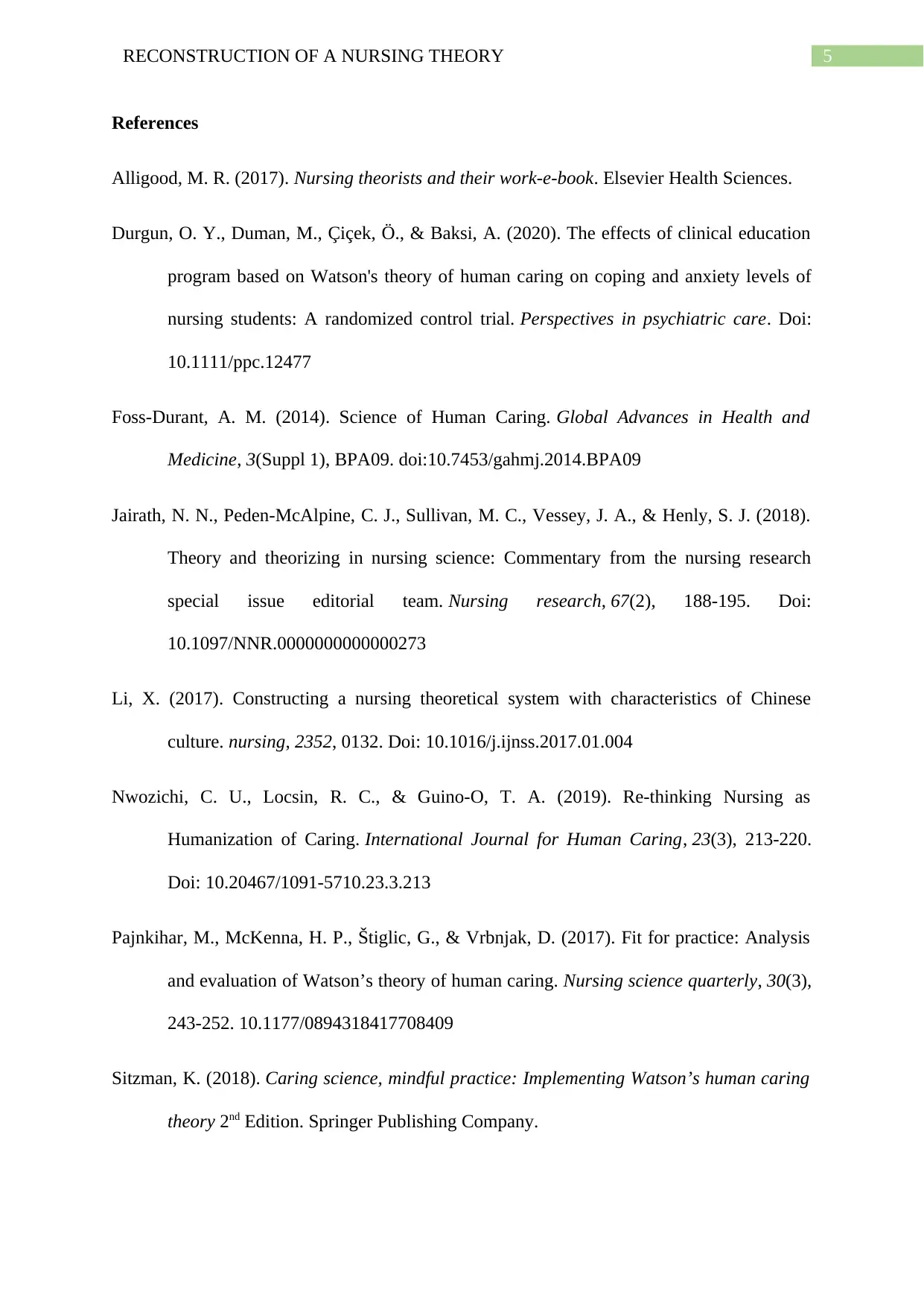
5RECONSTRUCTION OF A NURSING THEORY
References
Alligood, M. R. (2017). Nursing theorists and their work-e-book. Elsevier Health Sciences.
Durgun, O. Y., Duman, M., Çiçek, Ö., & Baksi, A. (2020). The effects of clinical education
program based on Watson's theory of human caring on coping and anxiety levels of
nursing students: A randomized control trial. Perspectives in psychiatric care. Doi:
10.1111/ppc.12477
Foss-Durant, A. M. (2014). Science of Human Caring. Global Advances in Health and
Medicine, 3(Suppl 1), BPA09. doi:10.7453/gahmj.2014.BPA09
Jairath, N. N., Peden-McAlpine, C. J., Sullivan, M. C., Vessey, J. A., & Henly, S. J. (2018).
Theory and theorizing in nursing science: Commentary from the nursing research
special issue editorial team. Nursing research, 67(2), 188-195. Doi:
10.1097/NNR.0000000000000273
Li, X. (2017). Constructing a nursing theoretical system with characteristics of Chinese
culture. nursing, 2352, 0132. Doi: 10.1016/j.ijnss.2017.01.004
Nwozichi, C. U., Locsin, R. C., & Guino-O, T. A. (2019). Re-thinking Nursing as
Humanization of Caring. International Journal for Human Caring, 23(3), 213-220.
Doi: 10.20467/1091-5710.23.3.213
Pajnkihar, M., McKenna, H. P., Štiglic, G., & Vrbnjak, D. (2017). Fit for practice: Analysis
and evaluation of Watson’s theory of human caring. Nursing science quarterly, 30(3),
243-252. 10.1177/0894318417708409
Sitzman, K. (2018). Caring science, mindful practice: Implementing Watson’s human caring
theory 2nd Edition. Springer Publishing Company.
References
Alligood, M. R. (2017). Nursing theorists and their work-e-book. Elsevier Health Sciences.
Durgun, O. Y., Duman, M., Çiçek, Ö., & Baksi, A. (2020). The effects of clinical education
program based on Watson's theory of human caring on coping and anxiety levels of
nursing students: A randomized control trial. Perspectives in psychiatric care. Doi:
10.1111/ppc.12477
Foss-Durant, A. M. (2014). Science of Human Caring. Global Advances in Health and
Medicine, 3(Suppl 1), BPA09. doi:10.7453/gahmj.2014.BPA09
Jairath, N. N., Peden-McAlpine, C. J., Sullivan, M. C., Vessey, J. A., & Henly, S. J. (2018).
Theory and theorizing in nursing science: Commentary from the nursing research
special issue editorial team. Nursing research, 67(2), 188-195. Doi:
10.1097/NNR.0000000000000273
Li, X. (2017). Constructing a nursing theoretical system with characteristics of Chinese
culture. nursing, 2352, 0132. Doi: 10.1016/j.ijnss.2017.01.004
Nwozichi, C. U., Locsin, R. C., & Guino-O, T. A. (2019). Re-thinking Nursing as
Humanization of Caring. International Journal for Human Caring, 23(3), 213-220.
Doi: 10.20467/1091-5710.23.3.213
Pajnkihar, M., McKenna, H. P., Štiglic, G., & Vrbnjak, D. (2017). Fit for practice: Analysis
and evaluation of Watson’s theory of human caring. Nursing science quarterly, 30(3),
243-252. 10.1177/0894318417708409
Sitzman, K. (2018). Caring science, mindful practice: Implementing Watson’s human caring
theory 2nd Edition. Springer Publishing Company.
⊘ This is a preview!⊘
Do you want full access?
Subscribe today to unlock all pages.

Trusted by 1+ million students worldwide
1 out of 6
Related Documents
Your All-in-One AI-Powered Toolkit for Academic Success.
+13062052269
info@desklib.com
Available 24*7 on WhatsApp / Email
![[object Object]](/_next/static/media/star-bottom.7253800d.svg)
Unlock your academic potential
Copyright © 2020–2025 A2Z Services. All Rights Reserved. Developed and managed by ZUCOL.





